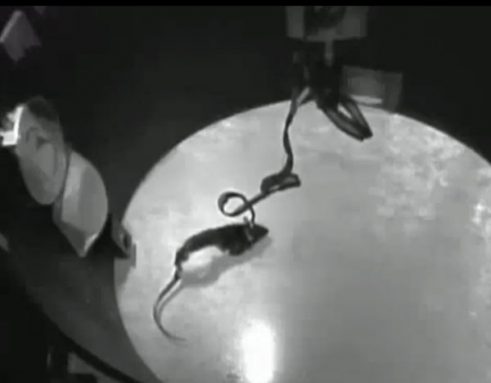Feeling the invisible
Sensor wired into a rat’s brain lets it detect light it can’t see
By Sid Perkins

A sensor wired to a portion of the rat brain that normally processes the sense of touch enabled a group of the laboratory animals to detect a form of light they cannot ordinarily see, scientists say. The new research underscores how adaptable the brain is. It also offers hope that someday people who have suffered severe brain damage or gone blind could regain some lost function.
In the experiment, Miguel Nicolelis and his colleagues mounted infrared sensors onto the scalps of rats. As a neuroscientist at Duke University in Durham, N.C., Nicolelis studies the brain and nervous system. Using tiny wires, his team recently connected the detectors to that part of the rat brain that normally interprets signals coming from the whiskers. The connection allowed the rats to sense the infrared light picked up by the detectors.
Normally, rats cannot see in the infrared. Infrared is just one form of electromagnetic radiation. X rays, radio waves and visible light are some other forms. The eyes of humans, rats and most other mammals can see only visible light, or the colors red through violet. Other colors along the electromagnetic spectrum are invisible to them. These include ultraviolet (ultra in Latin means “beyond”) and infrared (infra in Latin means “below”).
While most mammals cannot see in the infrared, scientists have designed electronic sensors that can. In fact, you probably use an infrared sensor or two every day. Televisions and DVD players use such detectors to receive infrared signals from remote controls.
The new experiment used similar sensors to let rats “see” infrared light too. Of course, their eyes remained blind to infrared light. So Nicolelis and his team bypassed their eyes. The researchers designed the experiment to see if the rats could use an area of their brain normally used in decoding touch signals to understand light signals. In the end, the rats learned how to “feel” infrared light.
Here is how: First, the team placed rats fitted with the infrared implants in a round chamber, roughly 1 meter (3 feet) in diameter. The chamber had several small holes in its circular wall. A light was next to each hole. In the beginning, the rats learned to access a water bottle through one of the holes. Researchers then started turning on the light outside the hole where water was available. (At the other holes, where there was no water, the light remained off.) Eventually the rats learned that a light signaled that water was available at a particular hole. Then the researchers changed the signal. Now they turned on an infrared light next to the hole where water was available.
Again, the rats could not detect this signal with their eyes. However, the infrared sensor could detect it. The detector passed along that information to the brains of the rats.
At first, the rats seemed confused whenever the sensors on their heads detected infrared light, says Nicolelis. “They rubbed their faces and cleaned their whiskers a lot,” he says. “This was a new sensation for them. In a sense, these rats were ‘feeling’ the light, not seeing it,” he explains.
Soon the rats learned to separate the sensations. Some came from the infrared sensors. Other were delivered by their whiskers. Before long, the rats started scanning their heads back and forth. That allowed the sensor to “look” for the infrared light that marked the hole with water. After 26 days, all six rats fitted with infrared sensors could find water more than 70 percent of the time. Over time, their success rate climbed to more than 90 percent. Nicolelis described his team’s experiments Feb. 17 at a meeting of the American Association for the Advancement of Science in Boston. The scientists also reported their results earlier in the week in Nature Communications.
The team’s experiment was designed to demonstrate the plasticity of brain function. “Plastic” in this sense means reshapable or adaptable. So the idea is that a part of the brain may be able to stretch its normal function to include new tasks. In this experiment, groups of nerves that normally decode one type of signal (touch) could learn to do the same with another (sight).
“This is a fascinating result,” says Todd Coleman. He’s a neuroscientist at the University of California, San Diego. “This study demonstrates just how adaptable the brain is,” he explains. It also suggests that researchers might one day help people whose brains have suffered damage through injury or disease. It would work by partially re-training one portion of the brain to do the work a damaged portion once did.
Taking advantage of the brain’s capacity to rewire itself wouldn’t fully restore a lost sense, Nicolelis cautions. For instance, a person who became blind might receive an implant that restored limited vision. The patient wouldn’t be able to see objects in great detail, only distinguish vague shapes.
Power Words
electromagnetic radiation Forms of light. Electromagnetic radiation is typically classified by its wavelength. The spectrum of electromagnetic radiation ranges from radio waves to gamma rays. It also includes microwaves and visible light.
infrared light A type of electromagnetic radiation invisible to the human eye. The name incorporates a Latin term and means “below red.” Infrared light has wavelengths longer than those visible to humans. Other invisible wavelengths include X rays, radio waves and microwaves.
neuroscientist A researcher who studies the nervous system of animals, including the brain.
plasticity Plastic means adaptable or reshapable. Here, it refers to the ability of the brain to stretch its normal function or abilities. This might include the brain’s ability to rewire itself to recover some lost functions and compensate for damage.







